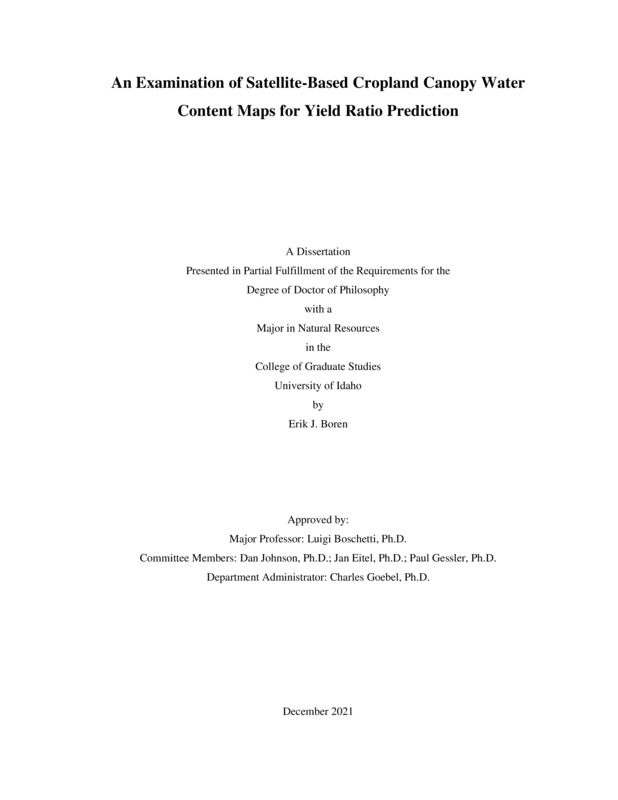An Examination of Satellite-Based Cropland Canopy Water Content Maps for Yield Ratio Prediction
Boren, Erik James. (2021-12). An Examination of Satellite-Based Cropland Canopy Water Content Maps for Yield Ratio Prediction. Theses and Dissertations Collection, University of Idaho Library Digital Collections. https://www.lib.uidaho.edu/digital/etd/items/boren_idaho_0089e_12179.html
- Title:
- An Examination of Satellite-Based Cropland Canopy Water Content Maps for Yield Ratio Prediction
- Author:
- Boren, Erik James
- ORCID:
- 0000-0003-0169-9792
- Date:
- 2021-12
- Keywords:
- Canopy Water Content Radiative Transfer Modeling Remote Sensing
- Program:
- Natural Resources
- Subject Category:
- Natural resource management; Agriculture
- Abstract:
-
While difficult to characterize, drought has been defined as a period of water shortage compared to normal conditions. Soil water availability has a larger impact on agricultural productivity than any other abiotic factor. It is critical to develop research which tracks the spatial and temporal patterns of drought as droughts become more frequent and severe, particularly in regions of high agricultural productivity. Traditional drought monitoring indices are based on point measurements of weather conditions from weather station instruments, which increase in uncertainty when extrapolating the measurements to spatially delineate the drought event, especially in data sparse regions. Satellite-based measurements, such as rainfall, evapotranspiration (ET), soil moisture, or vegetation health have increased in use to gap-fill the uncertainty from point-based measurements and increase the scale of drought monitoring. The spatial and temporal requirements for farm-level agricultural monitoring, however, create challenges when implementing remote sensing technology for drought and yield monitoring.
The research in this dissertation proposes a transferable method for using moderate resolution satellite imagery in physical-based radiative transfer model (RTM) inversion methods for retrieving cropland canopy water content (CCWC) as a direct indicator of crop water status for predicting yield. The method aims to alleviate the “ill-posed” nature of inversion problem solving by using phenology and crop species a priori information to dynamically constrain the inversion of the RTM, PRO4SAIL, for estimating CCWC at the 30-m pixel level. The 30-m CCWC product is integrated into a framework for predicting drought stress and yield loss by combining a previously published relationship between leaf water content (LWC) and available soil water content (ASWC) with the crop water use definitions outlined in Food and Agriculture Organization (FAO) Irrigation and Drainage paper 56 .
The leaf structure parameter (Ns) accounts for a large proportion of uncertainty in PRO4SAIL inversion problems as it is the only biophysical parameter that is not physically measurable. Chapter 1 examined whether there is statistically significant variation in Ns as a function of phenology, crop species type, and water status with the purpose of generating reference values of Ns to be used as a priori information in subsequent research. A total of 230 spectral measurements were taken from three monocotyledon species (hard red wheat, soft white wheat, and upland rice) and one dicotyledon species (soy) over two full growth seasons at the University of Idaho Pitkin’s Nursery. The spectral measurements were used to characterize Ns over phenology, crop species type, and water status. The study demonstrated that a significant relationship exists between phenology and Ns as well as a significant relationship between crop species type and Ns. No significant relationship was found between the water treatments of the study and Ns , providing evidence that water status and Ns are independent.In chapter 2, a novel PRO4SAIL inversion approach was proposed and tested using the Harmonized Landsat-Sentinel (HLS) surface reflectance product to estimate CCWC in wheat, barley, and garbanzo fields outside of Genesee, Idaho over three growing seasons. The inversion strategy used information about phenology and crop species to generate a set of Look-up Tables (LUTs) for each overpass date. A set of 225 leaf measurements were used to train the LUTs, and 102 independent field measurements were used to validate the inversion. The novel crop and time dependent strategy had the best performance when compared to a phenology specific LUT strategy, and single nominal range LUT inversion strategy. The results showed the potential of an operational HLS-based CCWC product which may serve as the basis for further improvement.
Chapter 3 presents a study which examines the feasibility of using a satellite derived time series of CCWC to predict the yield ratio in maize, defined as the ratio between actual harvested yield and maximum potential yield. The paper establishes the relationships between CCWC, drought stress, and yield ratio by combining a logistic relationship between LWC and ASWC with FAO-56 definitions of water balance, drought, and yield. Using these definitions, and known relationships between PRO4SAIL biophysical parameters, CCWC, NDVI, and yield ratio were modeled for different treatments of an independent irrigation experiment which created late drought conditions in Inner Mongolia, China. Coincident Landsat-8 Operational Land Imager (OLI) scenes were used to create the PRO4SAIL estimated CCWC and observed NDVI time series. The results demonstrated the first steps towards s farm-level yield ratio prediction using physical-based estimation of CCWC with FAO-56 soil water balance methods. The implications of the study highlight a potential for using CCWC in yield ratio prediction and justify future field-level irrigation treatment research with ground measured yield for testing the CCWC-yield relationship.
- Description:
- doctoral, Ph.D., Natural Resources -- University of Idaho - College of Graduate Studies, 2021-12
- Major Professor:
- Boschetti, Luigi
- Committee:
- Johnson, Dan M; Eitel, Jan ; Gessler, Paul; Goebel, Charles
- Defense Date:
- 2021-12
- Identifier:
- Boren_idaho_0089E_12179
- Type:
- Text
- Format Original:
- Format:
- application/pdf
- Rights:
- In Copyright - Educational Use Permitted. For more information, please contact University of Idaho Library Special Collections and Archives Department at libspec@uidaho.edu.
- Standardized Rights:
- http://rightsstatements.org/vocab/InC-EDU/1.0/

